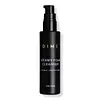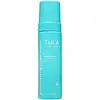What's inside
What's inside
 Key Ingredients
Key Ingredients

 Benefits
Benefits

 Concerns
Concerns

 Ingredients Side-by-side
Ingredients Side-by-side

Water
Skin ConditioningButylene Glycol
HumectantPentylene Glycol
Skin ConditioningGlycerin
HumectantSodium Cocoyl Glutamate
CleansingCoco-Betaine
CleansingCaprylyl Glycol
EmollientCetyl Hydroxyethylcellulose
Emulsion StabilisingPCA Ethyl Cocoyl Arginate
MoisturisingPyrus Malus Fruit Extract
Skin ConditioningBeta Vulgaris Root Extract
Skin ConditioningFructooligosaccharides
HumectantGlycolic Acid
BufferingCaprylhydroxamic Acid
Piroctone Olamine
PreservativeTetrasodium Glutamate Diacetate
Bakuchiol
AntimicrobialSodium PCA
HumectantAloe Barbadensis Leaf Juice
Skin ConditioningArtemisia Vulgaris Extract
Skin ConditioningDipotassium Glycyrrhizate
HumectantLaminaria Digitata Extract
Skin ProtectingZinc PCA
HumectantCinnamomum Cassia Bark Extract
MaskingSanguisorba Officinalis Root Extract
CleansingZingiber Officinale Root Extract
MaskingWater, Butylene Glycol, Pentylene Glycol, Glycerin, Sodium Cocoyl Glutamate, Coco-Betaine, Caprylyl Glycol, Cetyl Hydroxyethylcellulose, PCA Ethyl Cocoyl Arginate, Pyrus Malus Fruit Extract, Beta Vulgaris Root Extract, Fructooligosaccharides, Glycolic Acid, Caprylhydroxamic Acid, Piroctone Olamine, Tetrasodium Glutamate Diacetate, Bakuchiol, Sodium PCA, Aloe Barbadensis Leaf Juice, Artemisia Vulgaris Extract, Dipotassium Glycyrrhizate, Laminaria Digitata Extract, Zinc PCA, Cinnamomum Cassia Bark Extract, Sanguisorba Officinalis Root Extract, Zingiber Officinale Root Extract
Salicylic Acid 2%
MaskingWater
Skin ConditioningSodium Methyl 2-Sulfolaurate
CleansingDisodium 2-Sulfolaurate
CleansingDisodium Laureth Sulfosuccinate
CleansingLactococcus Ferment Lysate
Skin ConditioningMelaleuca Alternifolia Leaf Oil
AntioxidantAzelaic Acid
BufferingMorinda Citrifolia Extract
AstringentGlycyrrhiza Glabra Root Extract
BleachingVaccinium Angustifolium Fruit Extract
Skin ProtectingZingiber Officinale Root Extract
MaskingLactic Acid
BufferingHydrolyzed Algin
Glycerin
HumectantCitric Acid
BufferingPhospholipids
Skin ConditioningCaprylyl Glycol
EmollientSodium Chloride
MaskingBenzoic Acid
MaskingSodium Hydroxide
BufferingSodium Glycolate
BufferingTrisodium Dicarboxymethyl Alaninate
Butylene Glycol
HumectantChlorphenesin
AntimicrobialSodium Benzoate
MaskingEthylhexylglycerin
Skin ConditioningPhenoxyethanol
PreservativeSalicylic Acid 2%, Water, Sodium Methyl 2-Sulfolaurate, Disodium 2-Sulfolaurate, Disodium Laureth Sulfosuccinate, Lactococcus Ferment Lysate, Melaleuca Alternifolia Leaf Oil, Azelaic Acid, Morinda Citrifolia Extract, Glycyrrhiza Glabra Root Extract, Vaccinium Angustifolium Fruit Extract, Zingiber Officinale Root Extract, Lactic Acid, Hydrolyzed Algin, Glycerin, Citric Acid, Phospholipids, Caprylyl Glycol, Sodium Chloride, Benzoic Acid, Sodium Hydroxide, Sodium Glycolate, Trisodium Dicarboxymethyl Alaninate, Butylene Glycol, Chlorphenesin, Sodium Benzoate, Ethylhexylglycerin, Phenoxyethanol
 Reviews
Reviews

Ingredients Explained
These ingredients are found in both products.
Ingredients higher up in an ingredient list are typically present in a larger amount.
Butylene Glycol (or BG) is used within cosmetic products for a few different reasons:
Overall, Butylene Glycol is a safe and well-rounded ingredient that works well with other ingredients.
Though this ingredient works well with most skin types, some people with sensitive skin may experience a reaction such as allergic rashes, closed comedones, or itchiness.
Learn more about Butylene GlycolCaprylyl Glycol is a humectant and emollient, meaning it attracts and preserves moisture.
It is a common ingredient in many products, especially those designed to hydrate skin. The primary benefits are retaining moisture, skin softening, and promoting a healthy skin barrier.
Though Caprylyl Glycol is an alcohol derived from fatty acids, it is not the kind that can dry out skin.
This ingredient is also used as a preservative to extend the life of products. It has slight antimicrobial properties.
Learn more about Caprylyl GlycolGlycerin is already naturally found in your skin. It helps moisturize and protect your skin.
A study from 2016 found glycerin to be more effective as a humectant than AHAs and hyaluronic acid.
As a humectant, it helps the skin stay hydrated by pulling moisture to your skin. The low molecular weight of glycerin allows it to pull moisture into the deeper layers of your skin.
Hydrated skin improves your skin barrier; Your skin barrier helps protect against irritants and bacteria.
Glycerin has also been found to have antimicrobial and antiviral properties. Due to these properties, glycerin is often used in wound and burn treatments.
In cosmetics, glycerin is usually derived from plants such as soybean or palm. However, it can also be sourced from animals, such as tallow or animal fat.
This ingredient is organic, colorless, odorless, and non-toxic.
Glycerin is the name for this ingredient in American English. British English uses Glycerol/Glycerine.
Learn more about GlycerinWater. It's the most common cosmetic ingredient of all. You'll usually see it at the top of ingredient lists, meaning that it makes up the largest part of the product.
So why is it so popular? Water most often acts as a solvent - this means that it helps dissolve other ingredients into the formulation.
You'll also recognize water as that liquid we all need to stay alive. If you see this, drink a glass of water. Stay hydrated!
Learn more about WaterZingiber Officinale is more commonly known as ginger.
Ginger root has antioxidant, anti-inflammation, and antimicrobial properties.
The antioxidant properties help protect your body from free-radicals. Free-radicals are molecules that may damage your skin cells. As a result, ginger may help slow down signs of aging such as hyperpigmentation and wrinkles.
Studies show ginger inhibits the enzyme that breaks down collagen. It also helps with:
This ingredient has no negative side-effects and is safe to use unless one has a specific allergy to it.
Ginger originates from Southeast Asia but has spread throughout the world. It is now a common spice used in many cultures.
Learn more about Zingiber Officinale Root Extract